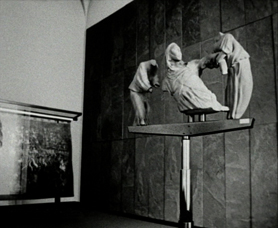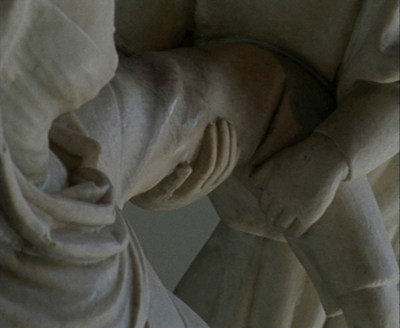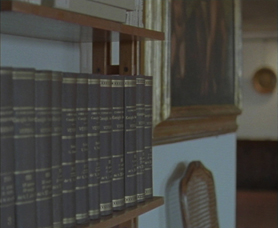Neue Museen
(UK 2011, 16mm, 11.00 mins.)
Distributed by LUX.
Neue Museen is a 16mm film about the radical, modernist exhibition designs of Italian post-war architect Franco Albini and his collaboration with museum director Caterina Marcenaro in the early 1950s. The film is shot in the galleries of the Palazzo Bianco and Palazzo Rosso, and the Museo di Sant’Agostino, in Genoa.
Albini and Marcenaro’s desire was to literally ‘float’ art in the museum, and the film reconstructs Albini’s unprecedented and extraordinary hydraulic lifting and rotating support for Giovanni Pisano’s ‘Fragment from the Tomb of Margaret Of Brabant’ (1313). This device, which now looks utterly eccentric, can be seen as one of the first examples of interactive museum sculpture display. Along with a range of innovative hinged supports that allowed paintings to be moved horizontally away from the wall, it was installed in the Palazzo Bianco in 1951 as the focal point of the post-war reconstruction of the museum. It was subsequently de-installed and put into storage in the early 1970s and now resides in the basement of the Museo di Sant’Agostino.
The appropriateness of Albini’s device was much commented on at the time of its installation, primarily because it was adapted from a ‘found’ hydraulic car hoist. In defense of Albini’s provocative display system Marcenaro claimed its mobility was central to ‘a new museum concept’ that emphasised truth, serenity and visibility. In his important survey of post-war Museum design Neue Museen, Planung und Einrichtung (1965) Michael Brawne indicates that Albini’s designs “were the first to question accepted methods of display” and “were to prove enormously influential later”. G E Kidder Smith in Italy Builds. L’Italia Costrusce (1954) suggests that the arrangement of the room that housed the Pisano fragment represented “a landmark design” in the presentation of sculpture in a museum context.
The film focuses on Albini and Marcenaro’s stated desire to “emphasise the atmosphere of purity and tranquillity that surrounds a real masterpiece” as a particularly explicit example of the modernist ideology of the museum to radically decontextualise art from its surroundings. As Catherine Marcerano suggests in an article from 1954 (Museum vol. 7 no. 4, 1954): “In the interests of education, the Palace concept was abandoned and the museum criterion strictly adhered to. In other words, the works of art were treated not as the decorative part of a given setting, but as a world in themselves, sufficient to absorb the visitor’s full attention”. It’s this idea of a ‘museum criterion’ that is central to Albini’s designs and exhibition display. In effect his designs propose a certain kind of looking and it’s this form of absorption that the film draws the viewer into.
A limited number of black and white photographs of the installed mobile display device exist yet there appear to be no extant accounts or film footage of how it actually operated in the museum.
The film also refers to the remarkable relationship between Marcenaro, who also commissioned Albini to design an apartment on the top floor of the adjacent building to the Palazzo Rosso for her own use. The apartment was the subject of a feature in Domus (June 1955) entitled “The Apartment of an Art Lover”.
Neue Museen
A film by
GRAHAM ELLARD AND STEPHEN JOHNSTONE.
Original CGI visualisation created by
ELIOTT JOHNSON
The voice of Caterina Marcenaro:
ROBERTA CREMONCINI
Music:
“Sei Capricci (Capricci no. 2)”
Composed by Salvatore Sciarrino.
Performed by Barbara Luneberg.
Published by G. Riccardi & Co.
Bühnen-und-Musik Verlag GBMH.
Special thanks to:
ADELMO TADDEI
Direttore, Museo di Sant’Agostino, Genova.
PIERO BOCCARDO
Direttore dei Musei di Strada Nuova, Genova.
RAFFAELLA BESTA
MARISA FUGALI
Palazzo Bianco, Genova.
MARCO ALBINI
PAOLA ALBINI
Fondazione Franco Albini, Milan.
Negative Cutting
REEL SKILL
Post Production
SOHO FILM LAB
Colour Grading
JOHN HEATH
Sound Neg
MARTIN SAWYER
Titles
FRAMELINE DESIGN
Special thanks to:
ELIOTT JOHNSON
ROBERTA CREMONCINI
ROBERT LUMLEY
FRANCO LA RUSSA
TIM EMBLEM-ENGLISH
Research funded by the British Academy.
Research and production funded by a Museums & Exhibitions Collaboration Award, Association of Art Historians.
With additional support from the Department of Art, Goldsmiths College and the School of Art, Central Saint Martins College of Art and Design.
Distributed by LUX: www.lux.org.uk
top
work
home
|
|









|